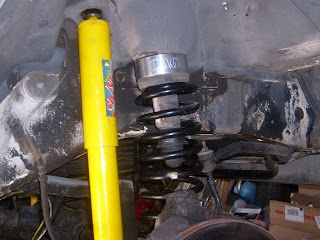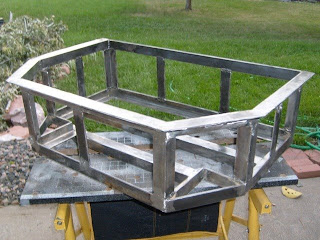This is a summary of the ElectroJeep project. Although the project is not 100% complete, it is close enough to document. I will update this posting as the last few items get done.
The project started in January of 2008, with the donor vehicle - a 1988 Jeep Cherokee XJ:

I decided to go with Azure Dynamics'
AC55/DMOC445 motor/controller combination, along with various interfaces which they provide:

The first step in any conversion is removing the Internal Combustion Engine. This typically requires an engine hoist and lots of elbow grease (and lots of real grease, too):

I also decided to go with lead-acid batteries. The weight this adds requires an upgrade to the suspension, so I purchased a heavy-duty lift kit (Old Man Emu):

Here is the front installed, along with a 1.5" lift block to provide enough clearance between the motor and the front differential:

Here is the rear installed. Yet to be done - I need to install an Add-A-Leaf kit to compensate for sagging in the rear:

Here is the Jeep with the lift installed and with essentially no weight inside - it makes it look like it will ride very high. This is an illusion. Once I add 500 pounds of motor, transmission, and battery racks, along with 1500 pounds of batteries, it will ride very close to where it started.

The motor is mated to the original transmission via a custom-built profile plate and hub from Electro Automotive. Here, my daughter KatC torques the bolts to spec:

Here is the motor mated to the transmission. Note that in the final design, the motor is actually rotated 180 degrees upside-down from what is shown here:

The motor is mounted via a cradle system which attaches to the original motor mounting points:

Thus. Here you can see that the motor is in fact "upside-down" to provide maximum clearance above the differential along with adequate spacing below the front battery rack:

The batteries themselves are sealed 12V Group 24 AGM batteries - the
Concorde Chairman AGM 1280T. They weigh 55 pounds each, and are spec'd to 80 amp-hours of juice:

I designed racks to hold the batteries and welded them from 3/16" angle stock. Here is the front rack, which holds 8 batteries:

This is the rear rack, which also holds 8 batteries:

This layout is required because this rack is sunk beneath the floor of the rear cargo space, and I need to avoid cutting structural members:

This is a third rack, the Upper Rear Battery Rack, which holds 7 batteries:

Under the rear seat are two batteries in individual racks:

Here you can see one of the racks welded into place:

The last battery is mounted in the front compartment in the same orientation as the original 12V battery, but on the driver's side. There is also a 27th 12V battery in the original battery location which provides power for all the 12V systems in the Jeep.
The batteries are interconnected with 4/0 gauge welding cable. Where it is exposed to possible damage, it is armored by plastic conduit:

The batteries in a rack are interconnected with copper straps. There are three 1/16" by 1" straps connecting each battery, which provides close to the same (low) resistance as 4/0 welding cable. The straps are bent to provide some degree of flexure to avoid levering the bolts out of the battery threads:

A variety of electronic components needed to be added. Here are some high-voltage fuses and a high-voltage relay:

Also, various 12V systems needed to be changed. Here are a circuit breaker and relay for the new electric power steering pump (see below):

This box contains several relays which interlock various systems. These relays do things like inform the controller that the system is plugged into the wall (so that you can't drive off when plugged in), they control the 300+V heater current, and they also control the DC-DC converter (see below):

In the rear, the charger is mounted. This charger can do the bulk charge of the full 312V string of batteries (the charge voltage is 372 volts!):

The charger connects to an inlet placed in the original gas tank filler location:

Various components in the front (power steering pump, controller, DC-DC converter) also required custom welding of racks:

Here is the electric power steering pump mounted and hooked up:

And here is the power brake vacuum pump and reservoir (note that the rat's nest of wiring has been cleaned up since this photo was taken!):

Here is the DC-DC converter in place. You can also see the 12V accessory battery. The 26th traction battery is mounted in the same orientation on the driver's side:

Also, the heating system was changed to electric. Two 400V 1000W ceramic heating elements were ganged together and placed in a custom box inside the heater box:

The throttle now operates a potentiometer in this "pot-box":

And the gauges have been upgraded to show various information necessary to run an electric vehicle. Shown here are the high-voltage volt meter (in the former gas gauge), along with new 12V amp and volt meters. Not shown are the 200A traction battery amp meter nor the PakTrakr battery monitoring system:

And that's where it stands. The vehicle is operational, mostly, but not yet street legal nor registered with the State. As I said, I will update this posting when the final bits-and-pieces are complete, so watch this space...




















































